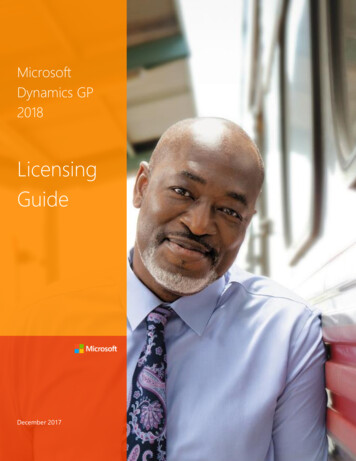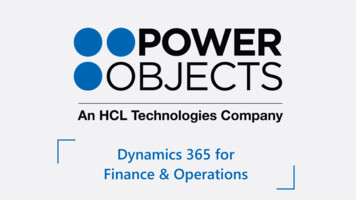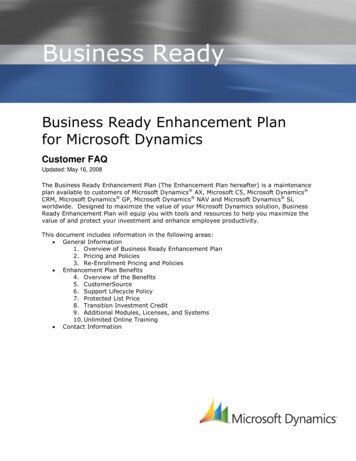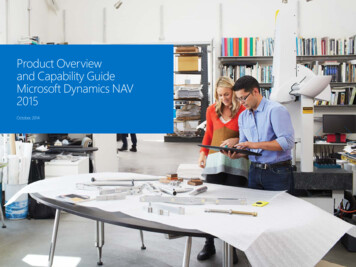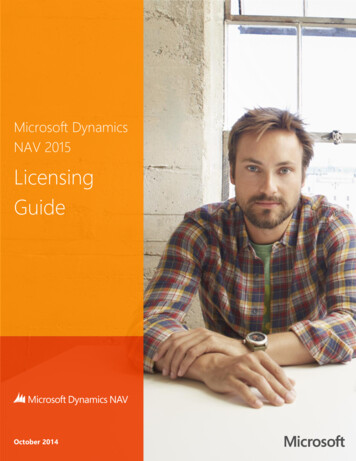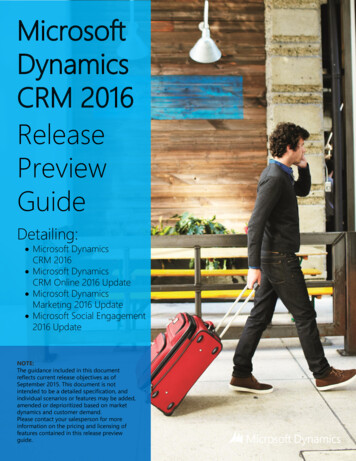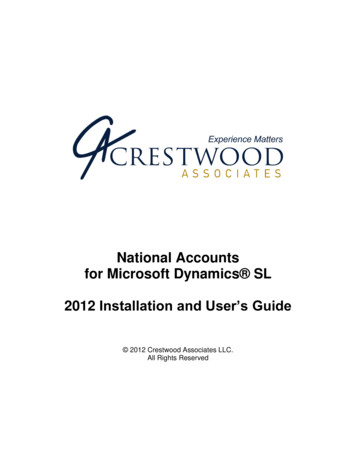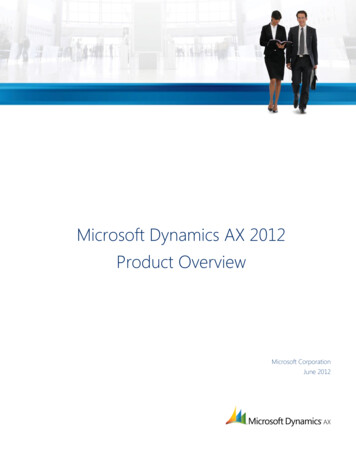
Transcription
Microsoft Dynamics AX 2012Product OverviewMicrosoft CorporationJune 2012
Microsoft Dynamics AX 2012Product OverviewTable of ContentsOverview . 3Industry-Specific Capabilities . 5Manufacturing . 5Retail. 5Distribution . 5Services Industries . 5Public Sector . 5Industry and Core ERP Capabilities . 6Financial Management . 6Human Capital Management . 8Production . 9Supply Chain Management . 11Procurement and Sourcing . 12Retail. 14Project Management and Accounting. 15Sales and Marketing (CRM) . 17Service Management . 18Business Intelligence and Reporting . 19Application Foundation . 20Reference Data . 20Master Data . 20Global Engines . 21Technology Framework . 22Clients . 22Servers . 23Tools . 24Microsoft Productivity and Application Platform Interoperability . 25Microsoft Dynamics AX 2012Product Overview2
Microsoft Dynamics AX 2012Product OverviewHow to Use This DocumentThis product overview is intended toconvey a high-level understanding of thestructure, key modules, features, andbenefits of Microsoft Dynamics AX 2012to readers that are not familiar with theproduct. It highlights the value deliveredto our key industry sectors includingmanufacturing, distribution, services, andPublic Sector. It then details thehorizontal application solutionsincluding financials, human resources,supply chain management, and others.Finally, the solution describes theapplication foundation, systemMicrosoft Dynamics AX 2012 is the Microsoft enterpriseresource planning (ERP) solution for enterprises thatempowers your people to anticipate and embrace changeso your business can thrive. It helps employees be moreproductive and increases the value of information byproviding all people in the organization with access tocritical business information and processes. Because itincludes rich industry and core ERP capabilities in a single,global solution, Microsoft Dynamics AX 2012 promotes fasttime-to-value. Simple to learn and use, it provides theagility you need to expand business opportunities, modifyprocesses, and differentiate your business. With pervasiveinteroperability, you can take advantage of existinginvestments, lower the total cost of ownership (TCO), andsupport innovation in your organization.framework, and interoperability with theMicrosoft productivity suite andapplication platform.Figure 1: Microsoft Dynamics AX 2012 product overview.The Microsoft Dynamics RoleTailored user interface includes more than30 Role Centers and makes it easy for everyone in key business areas toaccess and share self-service business intelligence (BI) and reporting.Organizations can license Microsoft Dynamics AX 2012 through a simplemodel based on user types that helps an organization buy licensesbased on the exact needs of their individual users with options to groweasily as needed.Microsoft Dynamics AX 2012Product Overview3
Microsoft Dynamics AX 2012Product OverviewOverviewIn a single solution, Microsoft Dynamics AX 2012 helps enterprises meet theirbusiness requirements easily with purposely built capabilities for fiveindustries (Manufacturing, Distribution, Retail, Public Sector, and Services). Inaddition, the core ERP capabilities support all users with financialmanagement, human capital management, supply chain management, salesand marketing, and more. Figure 2 shows a high-level overview of MicrosoftDynamics AX 2012 capabilities.The same single solution can support specific business requirements easilyby extending the industry foundation with packaged vertical solutionsfrom the Microsoft Partner Network, a large partner ecosystem of globalsystems integrators (GSIs), independent software vendors (ISVs), and value -added resellers (VARs). MicrosoftDynamics AX supports global organizations by managing multisite operations through shared reference data, masterdata, global engines, and business processes, as well as country-specific capabilities, in a single instance. Developmenttools such as Microsoft Visual Studio allow for easy customization to fit specific organization requirements.Figure 2: Microsoft Dynamics AX 2012 functional domains.Microsoft Dynamics AX 2012Product Overview4
Microsoft Dynamics AX 2012Product Overview: Industry-Specific CapabilitiesIndustry-Specific CapabilitiesManufacturingDistributionTake advantage of a single, unified solution that includesthe ability to run discrete, process, and leanmanufacturing all at once. Use powerful horizontalapplications such as production and supply chainmanagement to modernize and grow yourmanufacturing business. Key business processessupporting manufacturing industries include: Discrete manufacturing Process manufacturing Lean manufacturing Multisite planning and manufacturing Shop floor managementSupport rapidly changing conditions in a business withglobal complexity. Microsoft Dynamics AX 2012 offerskey capabilities such as supply chain management andmultisite to allow you to scale your business quickly.Distribution-specific capabilities include: Warehouse management Supply chain planning Sales order management Product information management Procurement and sourcingBalancing client relationships, globalresources, service delivery, andfinancial results is critical forcompanies in the services industry.Key capabilities include: Project managementand accounting Project budgeting andcost control Employee self-service Client relationship managementRetailToday’s retail landscape offers unprecedentedopportunity even as it presents new challenges.Economic pressures, increasing choice in products andshopping formats, and unparalleled access toinformation are fueling today’s empowered shoppers,who expect more from their retail experiences. Dynamicretailers drive retail across channels, locally or globally,with a single solution for store operations and backoffice ERP, including the following capabilities: Point-of-sale Multichannel management Store operations MerchandisingMicrosoft Dynamics AX 2012Services IndustriesPublic SectorGovernments need to modernize their workplaces byreplacing old technology, increasing productivity,operating transparently, meeting compliancerequirements, and maintaining fiscal accountability.Microsoft Dynamics AX 2012 offers Public Sectororganizations key capabilities including client(constituent) relationship management and financialmanagement. Specific Public Sector capabilities include: Grants management and multiyear CIP projectaccounting capabilities Budgetary control Fund-based accounting Encumbrance and pre-encumbrance accountingProduct Overview5
Microsoft Dynamics AX 2012Product Overview: Industry and Core ERP CapabilitiesIndustry and Core ERP CapabilitiesFinancial ManagementProvide a fast and efficient way to register financial transactions,manage relationships between subsidiaries and the parentorganization, and manage internal cost accounting. Gain financialinsight, help control expenditures, and support the enforcementof accounting policies and rules.Figure 3: Easily create organization hierarchies based on the financial dimensiondepartments to view and report on your business from different perspectives.ModuleDescriptionRole CentersAccountant, accounting manager, accounts payable coordinator, accounts receivableadministrator, bookkeeper, chief executive officer (CEO), chief financial officer (CFO),controller, treasurer, budget manager, environmental manager, credit andcollections manager.General ledgerFinancial accounting record management with ability to configure multiple andrecurring journals, allocation of cost and income, and support creation of closingtransactions, including preparation of preclosing documents and closing books. Gaininsight using unlimited financial dimensions and advanced account structures andrules.Bank managementMaintain the legal entity’s bank accounts and financial instruments that areassociated with those bank accounts. Monitor deposits, payments, drafts, and bankbalances with support for electronic payments. Manage letters of guarantee andchecks.Accounts payableMatch and pay invoices, allocate charges, pay expenses, commissions, and salaries,and track purchase order prepayments. Offer vendors access to relevant informationthrough the vendor portal.Accounts receivableTrack invoices, terms, and discounts. Process customer prepayments. Receive andenter customer payments. Monitor credit checks and manage collections withintegration to case management to centralize and monitor all activities per case.Fixed assetsManage the full accounting life cycle of assets from acquisition to depreciation, andtransfer/disposition.Cost accountingTrack, record, and analyze costs associated with products or activities includingnormal, absorption, and standard costing methods.Microsoft Dynamics AX 2012Product Overview6
Microsoft Dynamics AX 2012Product Overview: Industry and Core ERP CapabilitiesIntercompany accountingand shared services supportBook transactions across subsidiaries and the parent company. Consolidate financialrecords. Support shared services in organizations with multiple legal entities by usingcentralized processing of customer and vendor payments.Country-specific capabilitiesSupports multiple currencies, as well as country-specific capabilities to helporganizations meet local and regional financial regulations (such as value-added tax(VAT) requirements) and market requirements (such as electronic banking).Budgetary controlManage your organization’s budget including flexible configuration options, instantcalculation of available budget funds, pooling of budgets, and budget workflows forreview and approval.Compliance andinternal controlsHelp ensure compliance with laws, regulations, policies, and business rules. Managethe implementation and execution of internal controls with the Compliance Center.Define corporate policies for expenses, invoices, and purchase orders and automatethe auditing process with the Audit Workbench. Use electronic signatures to identifyand register the person changing and/or approving changes. The toolset issupplemented with a database log that enables administrators to see when a recordwas created or last changed, and who changed it. Ensure segregation of duties withrole-based security. Determine the organization’s environmental footprint using theEnvironmental Manager Role Center.Financial reportingFinancial statements enable a custom reporting structure and mapping of ledgeraccounts or dimensions to the reporting structures. Financial reports, to comply withlegal requirements and international accounting standards, include balance sheet,income statement, and cash flow statement. Financial statements are compatiblewith Extensible Business Reporting Language (XBRL).In addition, gain insight into the organization’s financials using transactional reports(retrieve data from the transaction processing database), analytical reports (retrievedata from Microsoft SQL Server Analysis Services cubes), and key performanceindicators (KPIs). Examples of predefined cubes for the financial domain are accountspayable, accounts receivable, environmental sustainability, and general ledger.Create boardroom-quality reports without IT assistance, consolidate across bothMicrosoft Dynamics ERP and other general ledgers, and take advantage of securereport distribution and storage through the centralized Report Library usingManagement Reporter.** Requires Management Reporter.Microsoft Dynamics AX 2012Product Overview7
Microsoft Dynamics AX 2012Product Overview: Industry and Core ERP CapabilitiesHuman Capital ManagementTake advantage of a comprehensive framework of human resourcemanagement capabilities including storing and managingemployee records, employee recruitment and training, andorganization management.Figure 4: Skill-gap analysis person–job.ModuleDescriptionRole CentersHuman resource manager, training manager.Organization administrationAdminister organizational structures, including formal and informal hierarchies andposition management.Recruitment andselection managementAdminister recruitment processes including campaigns, screening, developments,and candidate correspondence. Sites Services* extend the recruitment process with acloud-based service facilitating the job posting process to and application ofexternal candidates.Development andperformance administrationManage employee development and performance including development plans,skill-gap analysis tools, and periodic career discussions.Skill mappingAnalyze skills (gaps) based on job profiles and search for skills (including filtering andweighting of skills).TrainingSet up, deliver, and analyze training courses.Employee self-service portalManage personal information, enter timesheets, order products, do expenses, andmore with this single portal.Travel and expenseManage expenses with integrated workflow. Submit a travel requisition includingprojected cost of travel for approval. Define expense policies and automate thereimbursement of travel expenses. Gain insight into expense behavior with theexpense management cube.Benefits administrationDefine organizational benefit plans, enroll workers in benefits, assign dependentcoverage, and designate beneficiaries.Absence managementEstablish, communicate, and monitor absence policies.Time and attendanceTrack profile-based, clock-in/clock-out registrations for workers and generate payinformation to payroll system.Compensation managementManage employee compensation.* Check availability with your Microsoft Dynamics partner or local Microsoft office.Microsoft Dynamics AX 2012Product Overview8
Microsoft Dynamics AX 2012Product Overview: Industry and Core ERP CapabilitiesProductionMinimize lead times, fulfill customer demand, and manage yourresources to get great efficiency from your discrete, process, andlean manufacturing operations. Use real-time data to trackproduction progress, get more accurate delivery dates, andreduce costs. Execute multiple production strategies, includingconfigure-to-order, assemble-to-order, make-to-stock, andmake-to-order. Use both push and pull production controlmechanisms.Figure 5: User interfaces such as the kanban scheduling board feature an intuitivevisualization to help you stay on top of production job status.ModuleDescriptionRole CentersOperations manager, production manager.Material andcapacity planningOptimize production and materials planning, forecasting, and scheduling.Simultaneously schedule materials and capacity. Calculate available-to-promise(ATP) and capable-to-promise (CTP) deliveries. Plan and execute routing andoperations. Use finite or infinite planning.Production schedulingand sequencingUse finite or infinite scheduling, forward and backward from various dates. Quickly(re)schedule jobs and simulate alternatives by dragging Gantt chart items. Resolvescheduling overloads by reassigning operations to alternate work centers. Optimizescheduling across the organization with a unified resource model and schedulingengine. Improve machine utilization by combining similar products while lettingcustomers request multiple quality specifications per product.Resource managementSchedule and track material, shop, and manpower resources. Plan resources basedon production activities and capabilities of resources. Types of resources can be tool,machine, vendor, location, and human resource. Resource allocation principlesinclude resource requirement types: resource (group), type, capability, skill, course,certificate, and title.SubcontractingManage various ways of partnering with subcontractors including outsourcing ofroute operations, vendor-supplied items, and item provisioning to subcontractors.Link subcontractor purchase order (PO) to production order.Production bill of materials(BOM)Create a bill of materials for production including phantoms using a graphical BOMdesigner. Modify and track individual line items. Manage multilevel formulas orrecipes, coproducts, and byproducts. Use version control to release the right BOM,and electronic signatures to track changes.Microsoft Dynamics AX 2012Product Overview9
Microsoft Dynamics AX 2012Product Overview: Industry and Core ERP CapabilitiesProduct configurationConfigure custom products with a unique bill of materials and routing by usingthe product configurator. The product configuration models are based onconstraints, and can be used from sales order, sales quotation, purchase order, andproduction order.RoutingManage routing: Plan simple, sequential, and complex networks; use simultaneousroutes in the same network. Use rough-cut capacity and detailed schedulingcapabilities. Organize the shop floor into logical production units at individual sites.Production ordersCreate, schedule, view, track, split, roll back, or categorize production orders tomaximize efficiency. Create production orders from sales orders. Follow productionthrough creation, estimation, schedule, release, started, finished, and costed. Usescrap on BOM, resource, and route.Shop floor controlManage and track shop floor operations. Register products and resources and itemsfor operations and jobs including a touch-enabled data entry.Inventory dimensions forprocess manufacturingDefine multiple inventory dimensions, including dual units of measure, catch-weightcalculations, packaging codes, variations to the main item, and lots.Lean manufacturingModel manufacturing and logistics processes as production flows. Use kanbans andkanban boards to signal demand requirements.Production costingUnderstand work in progress (WIP) and actual cost through production tracking andreporting. Track detailed resource and throughput costs, including work center costs.Report production variances to standard costs.Production reportingGain insight with predefined KPIs in the SQL Server analysis data cube forproduction.Microsoft Dynamics AX 2012Product Overview10
Microsoft Dynamics AX 2012Product Overview: Industry and Core ERP CapabilitiesSupply Chain ManagementConnects sales and purchasing processes with logistics, production,and warehouse management to provide visibility and managementthroughout the supply chain. Manage distributed organizations withintercompany and multisite capabilities.Figure 6: Supply scheduling.ModuleDescriptionRole CentersPurchasing agent, purchasing manager, shipping and receiving, order processor.Inventory managementTrack items by inventory dimensions including site, warehouse, pallet, location, batch, andserial number. Take advantage of multiple inventory control systems and inventoryvaluation methods including first in/first out (FIFO), last in/first out (LIFO), standard cost,moving, and weighted average. Reduce inventory costs and eliminate waste by using theABC-analysis and by pulling inventory in optimal sequence using “best-before”management and first expired/first out (FEFO) or first in/first out (FIFO) picking guidance.Multisite warehousemanagementManage storage locations and material handling within warehouses. Apply advancedinbound algorithms using multiple warehouse zones and replenishment strategies.Optimize picking with a choice of picking methods. Track inventory on hand perwarehouse.Shipping carrier interfaceAutomatically transfer information received from shipping carriers (Fedex, UPS, and Kewill),including freight charges and tracking numbers, to Microsoft Dynamics AX.Quality managementImprove business processes for quality assurance, quality control, and lot traceability. Managethe test process. Set aside items in quarantine using quarantine orders.Product management ofgoods and servicesCentralize management of products and services across the organization includingBOM and process formulas (see Product Information Management).Returns managementManage the return order process. Control who can return items, and which items can bereturned. Categorize returns according to reason code or method of disposition.Master planning includingorder promisingForecast delivery dates using operations or bottleneck scheduling. Calculate available-topromise (ATP) and capable-to-promise (CTP). Plan across multiple sites.ForecastingEnter and edit sales and purchase forecasts. Use specific keys to allocate forecast toindividual items and time periods.IntercompanyAutomate trade between subsidiaries or distribution centers. Sales and purchaseorders can be generated manually or automatically across your subsidiaries.Microsoft Dynamics AX 2012Product Overview11
Microsoft Dynamics AX 2012Product Overview: Industry and Core ERP CapabilitiesProcurement and SourcingFacilitate direct and indirect procurement of goods and services, andestablish a centralized buyer capability across your organization tosupport procurement policies and processes.Figure 7: Catalog-based procurement.ModuleDescriptionRole CentersPurchasing agent, purchasing manager, employee, shipping and receiving,order processor.Direct procurementManage the entire life cycle of procurement from planned purchase order toconfirming and changing a purchase order. This cycle also includes returned orders.This module also supports direct deliveries, pro-forma purchase orders, and landedcost charges to purchase orders such as freight, insurance, and unrecoverable taxes.Trade agreements (vendor)Manage price and multifaceted discount policies in all currencies. The price revisionprocess can be governed by workflows to ensure compliance with internal policies.The generic currency agreement allows prices to be set up in a single currency andautomatically converted to the vendor’s currency.AgreementsManage agreements based on monetary or volume commitments. Organizations areable to set up agreements with specific terms and conditions and monitor the status.Request for quotations(RFQ)Manage the RFQ process including vendor reply, comparison, and selection.Replies can be entered by the vendor in the vendor portal. Take advantage of SitesServices* to extend the procurement process with a cloud-based service facilitatingthe RFQ process.Vendor managementVendor management includes vendor search, vendor maintenance, and support forrequesting and approving a new vendor via the Enterprise Portal supported byworkflow. Take advantage of Sites Services* to extend the vendor onboardingprocess with a cloud-based service facilitating the dialog with new vendors.Vendor self-service portalEnable vendors to update profile data, upload catalog content, and review invoicesand payments. Vendors can receive notifications from the organization, respond toRFQs, and view vendor performance.Microsoft Dynamics AX 2012Product Overview12
Microsoft Dynamics AX 2012Product Overview: Industry and Core ERP CapabilitiesIndirect procurement(catalog and non-catalog)Manage purchase requisitions of indirect goods and services using a catalog-basedor non-catalog-based procurement process. The procurement process is supportedby an approval workflow using the organizational hierarchy.A Microsoft SharePoint –based catalog can easily be created from products definedin product information management. The catalog also supports punch-outcapabilities to external vendor sites. Sophisticated budget check is included.Category managementProvides category managers the ability to define different category hierarchies thatare independent of, but still related to, commodity codes or catalog/item hierarchiesin order to easily manage the overall spending based on categories.Purchasing policies andsigning limitsEnforce purchasing policies with a collection of purchasing policy rules that controlthe procurement process. A centralized procurement desk defines policy rules tosupport global policies and processes, and applies them to purchase requisitions andpurchase orders based on the legal buying entity and operating unit. Forprocurement and sourcing there are six policy rules: catalog, catalog access,category, purchase requisition RFQ, purchase requisition control, and purchase ordercreation and demand consolidation. In addition to policy rules, Microsoft DynamicsAX 2012 provides expenditure reviewers and signing limits.Procurement reportingGain insight into the organization’s procurement performance using transactionalreports, analytical reports (such as vendor and procurement spend analysis, top 100vendors, vendor performance), and KPIs. A predefined data cube for purchasing isincluded.Procurement workflowsProcurement operations can be driven and governed by workflows. With the flexibleand visual workflow engine, procurement managers are able to set up workflows thatmake the procurement cycle more efficient and enforce purchasing policycompliance.* Check availability with your Microsoft Dynamics partner or local Microsoft office.Microsoft Dynamics AX 2012Product Overview13
Microsoft Dynamics AX 2012Product Overview: Industry and Core ERP CapabilitiesRetailExtend ERP with multichannel management, store operations,and merchandising. Microsoft Dynamics AX 2012 offersintegrated capabilities to run your retail operations with a singleplatform.Figure 8: A flexible RoleTailored interface, such as this point-of-sale (POS) screen,can help employees work productively and provide faster customer service.ModuleDescriptionPoint of sale (POS)POS components are natively integrated into Microsoft Dynamics AX 2012 with faulttolerance to capture transactions when store connectivity is lost. The POS userinterface (UI) is easily customizable by role with a “drag-and-drop” designer. POScapabilities include on-account, global voucher, returns management, info codes,returns/voids/markdowns, inventory receipt/lookup/counts, real-time customer recordand loyalty program updates, blind close, and floating till.Centralized storemanagementCentralized POS terminal management includes visual and functional profiles, userinterface layouts, and employee permissions. Consistent store/ERP data model andbusiness rules facilitate accurate, timely data. Data replication helps ensure criticalupdates across the organization including inventory and financial updates, sales orderpayments, gift card usage, and updates to loyalty programs. Maintain staff informationat store, regional, and global levels.MultichannelmanagementRetail channel integration with online marketplaces and stores creates newopportunities for sales, customer interaction, and feedback. Integrate assortment andcategory management across the channels. Improve customer convenience with crosschannel scenarios such as “buy online/pick up in store.”MerchandisingUse category management to centrally manage your assortment including creation,scheduling, tracking, and using n-level deep item hierarchies and categorymanagement. Optimize for profitability with multifaceted discounts, coupons, mixand-match, and buy-one-get-one scenarios.O
Microsoft Dynamics AX 2012 Product Overview 4 Microsoft Dynamics AX 2012 Overview In a single solution, Microsoft Dynamics AX 2012 helps enterprises meet their business requirements easily with purposely built capabilities for five industries (Manufacturing, Distribution, Retail, Public Sector, and Services). In


